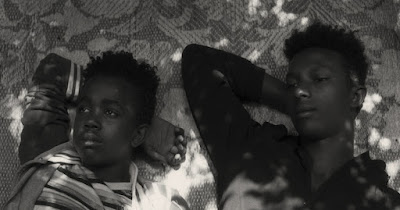We are almost halfway through 2022 and I still haven't caught up with all the worthy 2021 films. Still, I have seen a few that required a change to the Top films of 2021. So here goes.
Top 10 Films of 2021
1. The Great Indian Kitchen (2021, India, Jeo Baby)
As
the title indicates, there is food in the movie which will cause one to
get hungry. The food preparation and techniques are shown in incredible
detail but it becomes apparent that the film is more than about food.
And the kitchen is more than just a space to make food. The difference
in roles of the husband and wife are emphasized as are the expectations
of a woman in some segments of society. Even though this film is rooted
in South India, aspects about marriage and treatment of women are
applicable to many other patriarchal societies around the world. Credit
to the director Jeo Baby of how this depiction is shown, by repetition
of the same tasks, which definitely produced a visceral reaction in me.
2. Drive My Car (2021, Japan, Ryûsuke Hamaguchi)
The second of Hamaguchi’s films to be released in 2021 is an exquisite tender film that is funny, charming, emotional and intelligent. It is also that rare film which lives up to the hype and unanimous praise from all corners of the world.
3. Memoria (2021, Colombia/Thailand co-production, Apichatpong Weerasethakul)
The sound design opens a new dimension to Apichatpong’s previously explored themes of past/present, living/dead. In fact, the sound allows time/space to be collapsed and presents a new way to experience our world, a new way to make sense of our memories and dreams.
4. Wheel of Fortune and Fantasy (2021, Japan, Ryûsuke Hamaguchi)
The
first of the two Hamaguchi films released in 2021 is pure cinematic
delight. The playful structure, including abrupt zooms, reminds of Hong
Sang-soo’s cinema but the honesty and mature stories are a continuation
of what he explored in his earlier Happy Hour (2015). Another lovely surprise is the inclusion of an element that reflects our current pandemic world.
5. Întregalde (2021, Romania, Radu Muntean)
There
are no vampires in this contemplative film set in Transylvania yet
there are elements of morality and ethics that are relevant to our world
today. Those elements centre around doing good for others at the
expense of one’s needs.
6. The World After Us (2021, France, Louda Ben Salah-Cazanas)
A charming Parisian film that balances the sweetness of romance with the bitterness of a writer’s struggles.
7. A Night of Knowing Nothing (2021, India, Payal Kapadia)
Payal
Kapadia’s beautiful poetic film shows that despite decades of progress,
many things haven’t changed in India (or the world in general). In
fact, some things are regressing including basic human rights.
8. Fire in the Mountains (2021, India, Ajitpal Singh)
A
remarkable film which derives its power with a smart mix of dry humour
and plenty of heart. In the hands of another filmmaker, this could have
been a completely dramatic film but Ajitpal incorporates many light
hearted touches and that elevates the film.
9. Faya Dayi (2021, Ethiopia/USA/Qatar, Jessica Beshir)
An
immersive, hypnotic and poetic journey to Harar! With a photographer's
soul, Beshir lovingly captures the myths and rituals around Khat along
with its growth, sale and consumption.
10. Aleph (2021, USA/Croatia/Qatar, Iva Radivojevic)
Smartly
uses a Jorge Luis Borges short story as a spring board to explore
diverse stories in Buenos Aires, Greeland, Kathmandu, New York City and
the Sahara. Easily one of the most creative films of the year!
Honourable Mentions (alphabetical order):
Ahed’s Knee (2021, France/Israel/Germany, Nadav Lapid)
Ancient Soul (2021, Spain, Álvaro Gurrea)
Azor (2021, Switzerland/France/Argentina, Andreas Fontana)
The Card Counter (2021, USA/UK/China/Sweden, Paul Schrader)
The City of Wild Beasts (2021, Colombia/Ecuador, Henry Eduardo Rincón Orozco)
Hit the Road (2021, Iran, Panah Panahi)
Pebbles (2021, India, P.S. Vinothraj)
Straight to VHS (2021, Uruguay, Emilio Silva Torres)
Taming the Garden (2021, Switzerland/Germany/Georgia/Holland, Salomé Jashi)
What Do We See When We Look At the Sky? (2021, Georia/Germany, Aleksandre Koberidze)
















